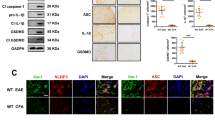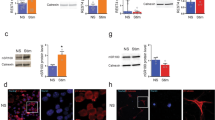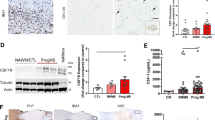Abstract
Microglia are crucial for the pathogenesis of multiple sclerosis and its animal model, experimental autoimmune encephalomyelitis (EAE). Here we show that the E3 ubiquitin ligase Peli1 is abundantly expressed in microglia and promotes microglial activation during the course of EAE induction. Peli1 mediates the induction of chemokines and proinflammatory cytokines in microglia and thereby promotes recruitment of T cells into the central nervous system. The severity of EAE is reduced in Peli1-deficient mice despite their competent induction of inflammatory T cells in the peripheral lymphoid organs. Notably, Peli1 regulates Toll-like receptor (TLR) pathway signaling by promoting degradation of TNF receptor–associated factor 3 (Traf3), a potent inhibitor of mitogen-activated protein kinase (MAPK) activation and gene induction. Ablation of Traf3 restores microglial activation and CNS inflammation after the induction of EAE in Peli1-deficient mice. These findings establish Peli1 as a microglia-specific mediator of autoimmune neuroinflammation and suggest a previously unknown signaling mechanism of Peli1 function.
This is a preview of subscription content, access via your institution
Access options
Subscribe to this journal
Receive 12 print issues and online access
$209.00 per year
only $17.42 per issue
Buy this article
- Purchase on SpringerLink
- Instant access to full article PDF
Prices may be subject to local taxes which are calculated during checkout






Similar content being viewed by others
Accession codes
References
Compston, A. & Coles, A. Multiple sclerosis. Lancet 372, 1502–1517 (2008).
Miller, S.D., Karpus, W.J. & Davidson, T.S. Experimental autoimmune encephalomyelitis in the mouse. Curr. Protoc. Immunol. Chapter 15, Unit 15.11 (2010).
Goverman, J. Autoimmune T cell responses in the central nervous system. Nat. Rev. Immunol. 9, 393–407 (2009).
Heppner, F.L. et al. Experimental autoimmune encephalomyelitis repressed by microglial paralysis. Nat. Med. 11, 146–152 (2005).
Ponomarev, E.D., Shriver, L.P., Maresz, K. & Dittel, B.N. Microglial cell activation and proliferation precedes the onset of CNS autoimmunity. J. Neurosci. Res. 81, 374–389 (2005).
Friese, M.A. & Fugger, L. T cells and microglia as drivers of multiple sclerosis pathology. Brain 130, 2755–2757 (2007).
Ginhoux, F. et al. Fate mapping analysis reveals that adult microglia derive from primitive macrophages. Science 330, 841–845 (2010).
Saijo, K. & Glass, C.K. Microglial cell origin and phenotypes in health and disease. Nat. Rev. Immunol. 11, 775–787 (2011).
Chastain, E.M., Duncan, D.S., Rodgers, J.M. & Miller, S.D. The role of antigen presenting cells in multiple sclerosis. Biochim. Biophys. Acta 1812, 265–274 (2011).
Gao, Z. & Tsirka, S.E. Animal models of MS reveal multiple roles of microglia in disease pathogenesis. Neurol. Res. Int. 2011, 383087 (2011).
Almolda, B., Gonzalez, B. & Castellano, B. Antigen presentation in EAE: role of microglia, macrophages and dendritic cells. Front. Biosci. 16, 1157–1171 (2011).
Ascherio, A. & Munger, K.L. Environmental risk factors for multiple sclerosis. Part I: the role of infection. Ann. Neurol. 61, 288–299 (2007).
Stromnes, I.M. & Goverman, J.M. Active induction of experimental allergic encephalomyelitis. Nat. Protoc. 1, 1810–1819 (2006).
Libbey, J.E. & Fujinami, R.S. Experimental autoimmune encephalomyelitis as a testing paradigm for adjuvants and vaccines. Vaccine 29, 3356–3362 (2011).
Berer, K. et al. Commensal microbiota and myelin autoantigen cooperate to trigger autoimmune demyelination. Nature 479, 538–541 (2011).
Gambuzza, M. et al. Targeting Toll-like receptors: emerging therapeutics for multiple sclerosis management. J. Neuroimmunol. 239, 1–12 (2011).
Prinz, M. et al. Innate immunity mediated by TLR9 modulates pathogenicity in an animal model of multiple sclerosis. J. Clin. Invest. 116, 456–464 (2006).
Olson, J.K. & Miller, S.D. Microglia initiate central nervous system innate and adaptive immune responses through multiple TLRs. J. Immunol. 173, 3916–3924 (2004).
Carpentier, P.A., Duncan, D.S. & Miller, S.D. Glial toll-like receptor signaling in central nervous system infection and autoimmunity. Brain Behav. Immun. 22, 140–147 (2008).
Akira, S., Uematsu, S. & Takeuchi, O. Pathogen recognition and innate immunity. Cell 124, 783–801 (2006).
Tseng, P.H. et al. Different modes of ubiquitination of the adaptor TRAF3 selectively activate the expression of type I interferons and proinflammatory cytokines. Nat. Immunol. 11, 70–75 (2010).
Häcker, H., Tseng, P.H. & Karin, M. Expanding TRAF function: TRAF3 as a tri-faced immune regulator. Nat. Rev. Immunol. 11, 457–468 (2011).
Schauvliege, R., Janssens, S. & Beyaert, R. Pellino proteins: novel players in TLR and IL-1R signalling. J. Cell Mol. Med. 11, 453–461 (2007).
Moynagh, P.N. The Pellino family: IRAK E3 ligases with emerging roles in innate immune signalling. Trends Immunol. 30, 33–42 (2009).
Jin, W., Chang, M. & Sun, S.C. Peli: a family of signal-responsive E3 ubiquitin ligases mediating TLR signaling and T-cell tolerance. Cell Mol. Immunol. 9, 113–122 (2012).
Chang, M., Jin, W. & Sun, S.C. Peli1 facilitates TRIF-dependent Toll-like receptor signaling and proinflammatory cytokine production. Nat. Immunol. 10, 1089–1095 (2009).
Okabe, M., Ikawa, M., Kominami, K., Nakanishi, T. & Nishimune, Y. 'Green mice' as a source of ubiquitous green cells. FEBS Lett. 407, 313–319 (1997).
Chang, M. et al. The ubiquitin ligase Peli1 negatively regulates T cell activation and prevents autoimmunity. Nat. Immunol. 12, 1002–1009 (2011).
Goh, E.T. et al. Identification of the protein kinases that activate the E3 ubiquitin ligase Pellino 1 in the innate immune system. Biochem. J. 441, 339–346 (2012).
Smith, H. et al. The role of TBK1 and IKKɛ in the expression and activation of Pellino 1. Biochem. J. 434, 537–548 (2011).
Li, L. et al. A small molecule Smac mimic potentiates TRAIL- and TNFα-mediated cell death. Science 305, 1471–1474 (2004).
Varfolomeev, E. et al. IAP antagonists induce autoubiquitination of c-IAPs, NF-κB activation, and TNFα-dependent apoptosis. Cell 131, 669–681 (2007).
Vince, J.E. et al. IAP antagonists target cIAP1 to induce TNFα-dependent apoptosis. Cell 131, 682–693 (2007).
Saijo, K., Collier, J.G., Li, A.C., Katzenellenbogen, J.A. & Glass, C.K. An ADIOL-ERβ-CtBP transrepression pathway negatively regulates microglia-mediated inflammation. Cell 145, 584–595 (2011).
Zhu, S. et al. Modulation of experimental autoimmune encephalomyelitis through TRAF3-mediated suppression of interleukin 17 receptor signaling. J. Exp. Med. 207, 2647–2662 (2010).
Eisele, S. et al. Prospects of transcript profiling for mRNAs and microRNAs using formalin-fixed and paraffin-embedded dissected autoptic multiple sclerosis lesions. Brain Pathol. 22, 607–618 (2012).
Gardam, S., Sierro, F., Basten, A., Mackay, F. & Brink, R. TRAF2 and TRAF3 signal adapters act cooperatively to control the maturation and survival signals delivered to B cells by the BAFF receptor. Immunity 28, 391–401 (2008).
Liao, G., Zhang, M., Harhaj, E.W. & Sun, S.C. Regulation of the NF-κB–inducing kinase by tumor necrosis factor receptor-associated factor 3-induced degradation. J. Biol. Chem. 279, 26243–26250 (2004).
Reiley, W.W. et al. Regulation of T cell development by the deubiquitinating enzyme CYLD. Nat. Immunol. 7, 411–417 (2006).
Jin, W., Zhou, X.F., Yu, J., Cheng, X. & Sun, S.C. Regulation of Th17 cell differentiation and EAE induction by the MAP3K NIK. Blood 113, 6603–6610 (2009).
Ajami, B., Bennett, J.L., Krieger, C., McNagny, K.M. & Rossi, F.M. Infiltrating monocytes trigger EAE progression, but do not contribute to the resident microglia pool. Nat. Neurosci. 14, 1142–1149 (2011).
Torkildsen, Ø. et al. Upregulation of immunoglobulin-related genes in cortical sections from multiple sclerosis patients. Brain Pathol. 20, 720–729 (2010).
Dysvik, B. & Jonassen, I. J-Express: exploring gene expression data using Java. Bioinformatics 17, 369–370 (2001).
Acknowledgements
We thank the Centenary Institute of Cancer Medicine and Cell Biology for Traf3-floxed mice; the Texas A&M Institute for Genomic Medicine for Peli1 knockout mice; S.H. Park (Sungkyunkwan University) for hemagglutinin (HA)-tagged Peli1 and Peli1ΔC; R. Beyaert (Ghent University) for E-tag–Peli1; Z. Chen (University of Texas Southwestern Medical Center) for HA-tagged K63 ubiquitin; C. Du (University of Cincinnati College of Medicine) for Flag–c-IAP2; S. Akira (Osaka University) for Flag-IKKi; and X. Qin (Sun Yat-Sen University) for lentiviral packing plasmids. We also thank the personnel from the flow cytometry, DNA analysis, animal and histology core facilities at MD Anderson Cancer Center for technical assistance. This research was supported by grants from the US National Institutes of Health (AI057555, AI064639 and GM84459 to S.-C.S. and T32CA009598 to G.C.B.).
Author information
Authors and Affiliations
Contributions
Y.X. designed and did the research, prepared the figures and wrote the manuscript. J.J., M.C., J.-H.C., H.H., X.Z., G.C.B. and X.C. contributed experiments. C.S. and Ø.T. performed the human microarray experiments. X.W. and R.B. contributed reagents. S.-C.S. supervised the research and wrote the manuscript.
Corresponding author
Ethics declarations
Competing interests
The authors declare no competing financial interests.
Supplementary information
Supplementary Text and Figures
Supplementary Figures 1–12 and Supplementary Tables 1 and 2 (PDF 5156 kb)
Rights and permissions
About this article
Cite this article
Xiao, Y., Jin, J., Chang, M. et al. Peli1 promotes microglia-mediated CNS inflammation by regulating Traf3 degradation. Nat Med 19, 595–602 (2013). https://doi.org/10.1038/nm.3111
Received:
Accepted:
Published:
Issue Date:
DOI: https://doi.org/10.1038/nm.3111



